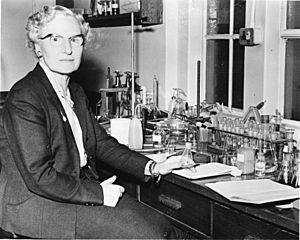Helen Porter facts for kids
Quick facts for kids
Helen Kemp Archbold
|
|
|---|---|
 |
|
| Born | 10 November 1899 Farnham, Surrey, England
|
| Died | 7 December 1987 (aged 88) |
| Citizenship | United Kingdoms |
| Alma mater | Bedford College, University of London and Imperial College London |
| Known for | Studies of polysaccharide metabolism in plants |
| Scientific career | |
| Fields | Biology, botany |
| Institutions | Imperial College London |
| Thesis | (1932) |
Helen Kemp Porter was a brilliant British botanist and scientist. She worked at Imperial College London, a famous university. She was a top member of the Royal Society, which is a big honor for scientists. Helen Porter was also the very first female professor at Imperial College London.
Her research was super important, especially her work on how tobacco plants use sugars. She was one of the first scientists in Britain to use new and exciting tools. These tools included chromatography, which separates mixtures, and radioactive tracers, which help track things inside plants.
Her Early Life and Family
Helen Kemp Archbold was born in 1899 in Farnham, England. Her dad was a school headmaster, and her mom was a professional singer. When Helen was two, her family moved to Bristol.
She learned a lot at home when she was young. She became good at reading and writing both French and English. Helen had one older sister.
When World War I started, her family had to split up. Her mom went to London to help with government kitchens. Her dad moved to a different school. Helen and her sister stayed in Bristol and went to Clifton High School for Girls.
Helen loved to travel when she was young. She even canoed the Danube River in the 1920s. She also visited old historical sites in the Middle East.
In 1937, Helen married William George Porter, who was a doctor. He passed away a few years later, but Helen kept his last name for her work. She married again in 1962 to Professor Arthur St George Huggett. He was a professor of how bodies work (physiology). He passed away in 1968.
Throughout her life, Helen loved needlework. She often made art based on scientific pictures. She lived to be 88 years old and passed away in 1987.
Her Education and Learning
Helen started at Clifton High School for Girls in 1906 when she was six. She did very well in all her subjects and finished school in 1917.
When she was thirteen, a great teacher made her interested in science. She went to Bedford College, which was a college for women at the University of London. There, she studied chemistry, physics, and math. She earned degrees in physics and chemistry with high honors.
Later, she earned her D.Sc. (a very high science degree) from London University in 1932. She also got a special diploma from Imperial College London. To help with her later work in biology, she also studied at Birkbeck College and Chelsea Polytechnical College.
Her Amazing Science Career
Helen Porter continued her studies at Imperial College London. She worked in a lab that studied organic chemistry.
In 1922, she joined a research team at the Low Temperature Research Station. This team was connected to Cambridge University. They were studying why apples went bad in cold storage. This was a big problem for people who imported fruit.
Helen's team looked at how apples "breathed" (respiration). They also studied the sugars, starches, and other chemicals inside the fruit. Her research grew to understand how these chemicals helped apples grow and ripen. She also looked at how these chemicals moved around in the fruit. By 1931, her team understood the chemical changes in stored apples.
After her apple studies ended, Helen became a visiting lecturer. She also started working with the Research Institute of Plant Physiology at Imperial College. There, she researched how plants like barley use carbohydrates (sugars and starches). She found that the starch in barley grains is made directly in the grain itself. This was different from what many scientists thought at the time.
When World War II started, Helen moved to a different lab. In 1947, she went to the United States for a year. She worked with Nobel Prize-winning scientists Carl Ferdinand Cori and Gerty Cori. She studied how enzymes help make and break down starch.
In 1953, Helen Porter became the head of her own research group at Imperial College. She got money from the Nuffield Foundation to do this. Her group used new methods like chromatography and radioactive labels. These tools helped them study how plants use energy and make sugars. She used radioactive starches and glucose in her experiments. This helped her see how things moved inside living tobacco plants. She was one of the first scientists in Britain to do this.
Because of her important research, she was chosen as a Fellow of the Royal Society in 1956. This is a very high honor for a scientist. The next year, she became a top scientist at the Institute of Plant Physiology. She was also made a Reader of Enzymology in the Botany Department.
In 1959, Helen became the head of Imperial College's Department of Plant Physiology. This made her the college's first female professor! She retired from this role in 1964. She also helped create special groups within the Biochemical Society. In 1965, she became the Chairman of the Biochemical Society. She made important changes to how the society worked.
In 1966, she was honored again as a Fellow of the Imperial College of Science and Technology. In 1972, she became an adviser to the Agricultural Research Council. Throughout her long career, Helen Porter wrote or helped write 39 scientific papers.
See also
 In Spanish: Helen Porter para niños
In Spanish: Helen Porter para niños


